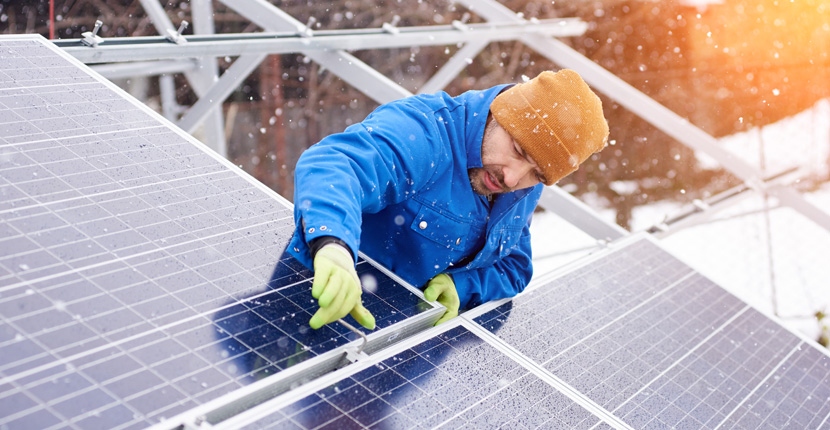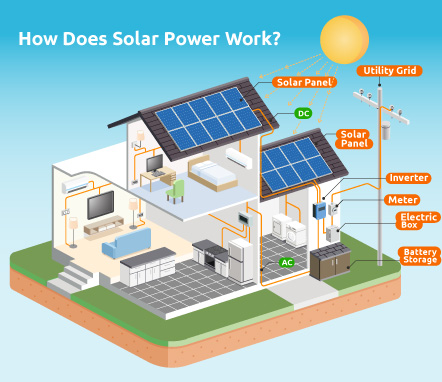How To Keep Solar Batteries Warm in Winter and Solar Batteries 101
- by Joe Weber - updated on 11/3/2023

A deep-cycle solar battery is a must-have addition to your solar setup. It stores energy that is captured by the sun to use later in the event you lose power from the utility grid or if the sun mysteriously disappears for a long period.
Learn more about solar energy storage and how to keep these helpful batteries warm and protected during the winter months so your batteries are always healthy and operating efficiently.
What Is A Solar Battery?
Let's start with a simple question. What exactly is a solar battery?
A solar battery is a necessary component of any home or business solar energy system. The batteries store any energy that is collected through solar panels for use when there is no sun to generate energy. Solar panels alone will only generate electricity when there is sunlight. When there is no sun there is no energy available to continue to use things like household appliances, lights or emergency equipment unless your solar energy system also has batteries.
Another downside of not having solar batteries is that any excess energy collected by the solar panels will go straight back to the power grid for others to use. Which, in basic terms, means that you are generating electricity for other people to use.
How Do Solar Energy Storage Batteries Work?
At a basic level, these are the five basic components of the energy storage process.
- Solar panels absorb energy from sunlight.
- The energy collected flows through an inverter to convert the direct current (DC) electricity to alternating current (AC) electricity.
- The AC electricity powers your home.
- Any extra energy not used will be used to charge your batteries or exported to the power grid.
- When the sun goes down or is blocked by prolonged cloud cover, your home and appliances will use the energy stored in the batteries.


To go a little deeper, let's first have a quick lesson on how solar panel systems work.
When residential solar panels are installed they are typically installed as a "grid-tied" or net-metered solar panel system. Essentially this means that when you are producing more energy than you are using, the leftover electricity is sent back to the power grid for others to use.
This also means that you are still connected to the power if you are not producing enough energy and need to use grid power and are then billed for that usage by the utility company as you normally would. Net-metering works by allowing your meter to run in reverse when you produce more electricity than needed as it is released back into the grid.
With a solar plus battery storage system, instead of sending excess electricity to the grid whenever you produce more electricity than you use, you can first use the extra energy to charge your batteries for power when the sun goes down. Rather than drawing energy from the power grid, you will first use up the energy stored in the batteries. If after charging the batteries there is still an excess of energy created, it will then be sent out to the grid.
What Batteries are Good for Solar Energy Storage?
Two chemistries of battery work best for solar energy storage, lithium and lead-acid.
Lithium Iron Phosphate deep cycle batteries provide several benefits compared to other batteries.
- Higher depth of discharge
- Considerably longer life
- Holds a charge for longer
- Smaller and lighter than other batteries
One drawback of lithium batteries is their cost. With all of the advanced technology that goes into producing lithium batteries, they do tend to be more expensive than lead-acid batteries. However, LiFePO4 batteries last so much longer that you will need to replace them less frequently and end up saving money in the long run.
Lead acid deep cycle batteries, the same chemistry as your car batteries, have been around for decades and have had years and years to evolve into the reliable batteries they are today. They are a great more budget-friendly alternative to lithium that will still provide strong power and ample energy storage for your solar system. Some lead-acid batteries require the occasional maintenance by adding water.
Why Do Batteries Underperform in the Winter Months?
Believe it or not cold is good for batteries, it keeps them from overheating, but too cold can be a problem. Where the cold becomes an issue is when it comes to consistent charging and discharging with deep discharges in very cold temperatures. Due to the cold temperatures, the chemical reactions that take place inside the batteries slow as it's supplied current. Cold temperature reduces current, which then in turn lowers that battery's capacity allowing less energy to be stored in the batteries.
This becomes a problem in renewable energy systems because solar systems usually coincide with higher usage in cold temperatures like during the winter months. With the higher likelihood of utilizing stored energy, reduced capacity can be a huge problem.
Most batteries are designed and rated at 77℉. This means that the battery's technical specifications are based on how the battery performs at 77℉. The technical specs could change if you are using your battery in a colder environment regularly.
How to Protect Batteries from the Cold and the Elements
Keep your batteries warm and protected from the elements by following these recommendations for each type of battery.
Flooded
Wet-cell or flooded lead-acid batteries can be charged at lower temperatures than lithium, but they do generally require the most attention in winter. Flooded lead acid batteries can not be installed inside your home because they vent potentially dangerous gasses.
- Keep flooded lead-acid batteries in battery boxes or enclosures with several 2" or larger holes near the top for ventilation.
- Have the batteries installed in the garage or a shed where they can stay warm and out of the elements but also have a safe area to ventilate.
- If the shed or garage is not insulated, reinforce the area where the batteries are being charged with insulation so they can remain warm even if the surrounding area is cooler.
Rigid insulation can be purchased at many hardware stores and you can use the rigid insulation and some plywood to construct an enclosed area for your batteries to stay warm. Don't permanently attach the plywood to the insulation. You'll need to remove the insulation when the temperature warms up in the spring. Remember to drill some ventilation holes!
AGM
Unlike flooded lead acid batteries, Absorbed Glass Mat (AGM) batteries are completely sealed with no venting. This makes them very versatile and can be installed indoors. You can still install them in a shed or garage but if you live in a very cold climate, you can install them in a basement. AGM batteries freeze at lower temperatures than flooded batteries but you still need to install them within an insulated area if they are going to be exposed to freezing temperatures.
Lithium
Advanced lithium batteries, especially lithium iron phosphate (LiFePO4) batteries that we sell at Batteries Plus, are the safest batteries on the market and can without question be installed indoors.
Special care must be taken if installing lithium batteries anywhere that is at risk of freezing as lithium batteries are the most sensitive to extreme temperatures. If lithium batteries are to be installed in an area at risk of freezing you will want to insulate the batteries in a similar manner listed above for flooded lead-acid batteries.
Lithium batteries should never be charged in below-freezing temperatures. Charging LiFePO4 batteries in below-freezing temperatures can cause lithium plating. Lithium plating is a process that lowers the battery's capacity and can cause short circuits. If these things occur you could damage the battery beyond repair and need to replace it earlier than expected.
Tools To Help Keep Batteries Healthy During Winter
There are several tools available to assist you with keeping your batteries healthy in the cold months.
Charge Controller
A charge controller monitors voltage and current so the batteries are brought up to the optimum charge levels. For larger solar panels, 200W or larger, a maximum power point tracking (MPPT) charge controller is recommended. MPPT controllers can squeeze an extra 15-30% more power out of the system than if you used a standard charge controller on large systems.
Battery Temperature Sensor
A battery temperature sensor is an easy way to add an early warning for batteries if the temperature drops below the recommended levels. Some charge controllers will stop charging when low temperatures are reached.
Battery Desulfators
Add extra life to your batteries by connecting them to a battery desulfator. Desulfators are a pretty straightforward tool to use to ensure that your batteries remain healthy. Connecting a desulfator to a battery will help remove lead sulfate from the plates that form over time. Removing the crystals will restore power and efficiency to the batteries.
Battery Management Systems
While most known for temperature sensing, battery management systems are much more than that. They include sensors for voltage and depth of discharge (DoD) at both the cell and battery level bank level. All of this information can be very helpful when identifying problem areas.
Battery management systems are absolutely necessary for lithium batteries to prevent overcharging and other problems. The good news here is that most LiFePO4 batteries on the market today include them built into the battery.
Add More Battery Storage
Sometimes the problems that present themselves only have one solution. You need more energy storage. As batteries age and their capacity decreases, sometimes the only answer is to add more batteries to your solar energy system.
Winter Battery Maintenance Tips
Outside of technology options that you can add to your solar energy storage systems, there are several things that you can do yourself to maintain your batteries to keep them healthy.
For lithium, AGM and flooded lead acid battery types you should perform an annual maintenance routine of checking and cleaning the terminals with baking soda and water to clean off any corrosion and then making sure the terminal clamps are clean and tight.
Flooded lead acid batteries require an additional step in their maintenance plan. Watering. You will want to occasionally snap the caps off of the battery to take a look at the electrolyte levels. If the levels are low enough that the lead plates are showing, it's time to top it off with distilled water. Not all flooded batteries require watering, read through our article "Does My Battery Need Watering?" to learn more.
Get Your Solar Solutions at Batteries Plus
Your local Batteries Plus has a large selection of deep-cycle lead acid batteries for your solar setup. Batteries Plus also offers an extensive selection of Goal Zero products for other renewable energy backup power solutions. If you'd like to learn more about our solar solutions for your camping and RV needs read our blog article "Find Your Solar Power Solution at Batteries Plus".